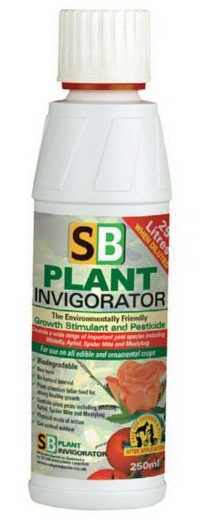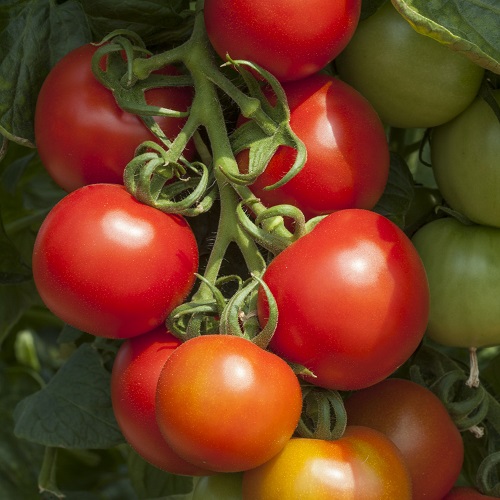| Tomato Crimson Crush is an excellent UK bred blight resistant variety. It will produces a heavy crop of large round tomatoes, with a good flavour. Not a over vigorous variety, so good for smaller gardens. Crimson Crush is well worth a try if you have struggled with growing tomatoes previously. Harvesting time will depend on sowing time and growing conditions. | | Tomato Crimson Crush Sowing Guidelines | | When to Sow Seeds: | Mid February to May | | Germination Temperature: | 18C + | | Cover Seed: | Lightly | | Time to Germinate: | 7 Days | | Frost Hardy: | No | | Spacing Between Plants: | 50cm | | Growth Habit: | Corden | | Plant Height: | 180cm + | |
General Tomato growing tips for plants with cordon habit.
All content on this page is copyright of Simplyseed and should not be reproduced without prior writen permission.
A crop of Crimson crush tomatoes will take around 15 weeks from seed to first harvest, being one of the earliest to fruit. Although you can sow seed from as early as late December in a heated greenhouse, it is more usual for most to sow in a unheated greenhouse or on the kitchen windowsill in March / April for planting out April / May.
Sowing
- Sow the tomato seed individually in cell trays, using a good quality seed compost. Lightly cover over and keep moist at a temperature of 18 degrees. Seedlings should start showing around 7 days if you have the right temperature.
- Prick out into 9cm pots once the seedlings are big enough.
- When the plants have reached 2 trues leaves, begin feeding weekly with a weak tomato feed.
Growing On
- Once the plants are 20cm tall, they can be planted in their final positions. Because tomatoes like the warmth you will always get a earlier and bigger crop from greenhouse grown plants.
- Greenhouse grown plants can be planted April onwards. Plants for outside should be hardened off, before planting out. Plant under cloches in early May, otherwise leave till June and plant out then. Again this will all depend on weather and risk of frost!
- Carry on feeding weekly. Increase the strenght of the feed as the plant grows. We believe lack of feed is the main reason that people fail in growing a decent crop of tomatoes. The feed should include a balance of Nitrogen, Potassium and Phosphorus (NPK) and ideally should include Trace Elements as well.
- Being a cordon variety Tomato Mountain Magic will need support as it grows. String can be used, tied firmly to a strong support wire above and tied loosely around the base of the plant. The plants are then twisted round the string as they grow. The direction of twisting doesn’t matter, but be consistent; otherwise you will untwist the ones you did earlier! Canes can be used, but be careful that heavily loaded plants may slide down unless tied securely. At the same time make sure you don’t strangle the plant stems.
- Other Tasks.
Sideshoots should be removed regularly before they get large. It should be possible to do this by hand but if they get too big a knife or secateurs should be used. Some leaves may need to be removed if very congested and old leaves should be removed from the bottom of the plant as they begin to age. They should snap out like sideshoots. Doing this will also allow easier picking off ripen fruits and reduce disease risk.
-
Pests & Diseases.
The worst pest for many will be White Fly. Try to avoid it by making sure there is none in the greenhouse in the first place. Many sprays are sold but the pest is not easy to control. SB Plant Invigorator is one of the best and tends to reduce White Fly and aphids, whilst at the same time giving a light feed of nitrogen.
The major disease under glass is Botrytis or Grey Mould. The spores are everywhere so there is no way to keep it out, but it needs a film of moisture and warmth to develop. Good ventilation and good hygiene can do a great deal to keep it at bay. A fungicide can be used if needed.
Although largely a disease of outdoor tomatoes, Potato Blight can be a problem under glass in some years for tomatoes in general..
Harvesting
- Tomato fruits ripen in response to warmth, so during cold weather or late in the season they will ripen very slowly. At the end of the season green fruit may be ripened indoors; keep them warm. Direct sunlight contributes little to ripening and too much may well damage the fruit.
- Ethylene is involved in ripening and this is given off by ripening Bananas, and the tale that keeping unripe Tomatoes next to ripening Bananas will help, is true- up to a point.
Remember! Beware of frost - Crimson Crush tomato plants are not hardy.


